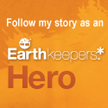The Canary Project is an organization that began in 2006, as a project to photograph landscapes around the world most acutely affected by global warming. It has since expanded to support a wide variety of other artists working at the intersection of art and ecology, as well as producing, supporting, and collaborating on other art projects, events, and educational mediums to build public understanding of human-induced climate change, and of course, to energize commitment solutions. The Canary Project is an outstanding example (and one of very few) of an organization exclusively dedicated to producing art about climate change.
The inaugural body of work, Canary Project Photos: The Landscape of Climate Change, affected me the first time I saw it. Susannah Sayler, a fine art landscape photographer, and co-founder of The Canary Project, set out to photograph locations around the world that are showing signs and fore-warnings of climate change, as well as those locations where successes in conservation and adaptation to climate change are visible. This second part of the project showing solutions is a key element, as so many times when we are witness to the atrocity of carelessness, which can feel completely and utterly overwhelming, a solution to the problem can seem unimaginable. Showing the positive affects of awareness and action to such awareness, not only proves wrong the skeptics who think nothing is wrong with our current state (by showing them the good, they can recognize the bad), but also offers hope and inspiration, important components when advocating for change.
Thus far, Sayler has photographed 11 of the 14 locations planned or a book and traveling exhibition, which were chosen in consultation with leading scientists and journalists, including the project’s scientific advisor, Dr. Paul Epstein of Harvard’s Center for Healthy and the Global Environment, and journalist Elizabeth Kolbert of the New Yorker. Locations include Alaska, New Orleans, Belize, Greenland, Antarctica, Siberia, Niger, and others on specific problems such as glacial and icecap melting, rising sea levels, drought and fires, extreme weather, and disrupted ecosystems.
The works themselves are quite beautiful. A quiet yet striking color palette, each exquisite in their sense of space and light, they take the landscape in as a whole, in context with their larger surroundings, providing clear view into what has been disrupted. Each image is accompanied by a caption detailing its specific location and time, and usually with a brief background on what has occurred there as evidence of climate disruption and change.

Disrupted Ecosystems: Great Barrier Reef, Belize, 2006

Drought and Fires: Gansu Province, China, 2007
Only fifty years ago, there was a lake here where we now see the tracks of a camel. In this short span of time, what was once the Qin Tu Hu Lake has dried up completely.

Drought and Fires: Umatilla National Forest, Washington State, 2006. More than 100,000 acres burned.

Rising Sea Level: Venetian Lagoon, Italy, 2006. Rising sea levels in Venice may become so severe that they exceed the capacity of human preservation efforts.

Glacial, Icecap and Permafrost Melting: Pasterze Glacier, Austria, 2005.
Glacial runoff in an area that was covered by ice merely 10 years ago.

Solutions:Rising Sea Level: Dyke on the North Sea, The Netherlands, 2006
The Netherlands has a total of 260 miles of sea dykes to protect coastal areas from high tides and storm surges. The dykes are constantly being monitored and improved for predicted sea level rise in the coming years.

Solutions: Waterworks in the Netherlands, 2006
The Maeslantkering is a storm surge barrier that automatically closes to protect Rotterdam and surrounding towns from flooding in the case of an abnormally large storm surge. Each of the barrier “arms” is as tall as the Eiffel Tower if placed upright. If sea levels rise as predicted due to global warming, other nations may need to adopt similar mechanisms of protection.
The Intergovernmental Panel on Climate Change (IPCC) has predicted that sea levels will rise between 9 and 88 cm in the next 100 years due to global warming. “A quarter of The Netherlands lies below sea level… Another quarter, while slightly higher, is still low enough that, in the natural course of events, it would regularly be flooded” (Elizabeth Kolbert, Field Notes from a Catastrophe).
For more information and images from and on The Canary Project, please visit their website.


























